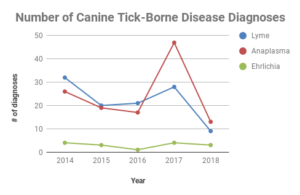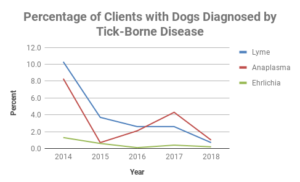
I recently was thinking that we were seeing much less Lyme disease in dogs in our local veterinary practice in the last year. I knew that we were still picking ticks off of dogs almost daily, with some variability by season, but we were getting fewer positive results from the annual screening blood tests that most dogs undergo. I also thought of this possible decline in tick-borne disease diagnoses because we were dispensing much less of the antibiotic doxycycline .
This prompted us to try to generate some information about the amount of each of the tick-borne diseases that we screen dogs for in our practice in West Concord Massachusetts: Lyme disease, Anaplasmosis, and Ehrlichia.
Our population of dogs is centered in Concord, Carlisle, Lincoln, Acton, Sudbury, and Maynard. We were pretty certain that we had more Lyme disease diagnoses in dogs when we were a much smaller practice in 2014 and 2015. We started our analysis by reaching out to our laboratory partner, Idexx, to get some raw data on the number of positive tests for the “big 3” tick-borne diseases that we screen for in dogs here in New England: Lyme, Anaplasma, and Ehrlichia. Notably, we do not routinely screen for Rocky Mountain Fever as it is not part of our annual 4DX test. To our dismay, the lab was not able to provide this information. With that disappointing news, we turned to another strategy.
Our veterinary practice management system allows us to give a diagnosis to each animal and assign it to their medical record. We used this raw data to compile the number of diagnoses of tick-borne disease instead of the number of positive tests. A diagnosis is not the same as a positive test and is a more subjective measurement of disease. A diagnosis takes in to consideration the test result, the medical history of the patient, and whether or not the dog is showing clinical signs and must be actively entered into the medical record by the doctor.
When we compiled our own in-house data, we were quite surprised. We looked at the number of diagnoses for each disease by year compared to the total number of clients by year. We were surprised by how much the number of diagnoses declined over time. The percentage of clients with a dog diagnosed with Lyme disease went from 10% to about 1% in the span of 2014 through the end of November 2018. Further, the decline in diagnoses was very steep from 2014 through 2015. See the attached graph.


Why such a dramatic drop in cases of tick-borne disease? It seems to mirror the introduction of the oral tick preventative afoxolaner (NexGard) to our practice in August of 2014. The isoxazoline class (NexGard, Bravecto, Simparica, Credelio) of oral tick preventatives in dogs has been very well accepted by our clients. We prescribed NexGard at our practice in the study period. We were surprised that an expensive, oral compound would be so well accepted as the former products were topically applied to the skin and thus had the appearance of more safety. Interestingly, we heard from our clients that they never liked the greasy hair coat that resulted from these products and they often doubted that the product actually became absorbed into the skin. After its introduction in late 2014 , we soon realized that the new oral product was selling well, was easy to use, and we suspected that is was very effective. This little bit of internal research confirmed our thoughts. The secret of the success appears to be the speed of the tick kill. Accordingly, Lyme disease diagnoses have dropped much more than Anaplasma, for example. This is because Anaplasma can transmit in as little as 6 hours but Lyme (Borrelia) requires 24 hrs or more of tick attachment to the canine host farmacie-romania.com. We also believe that there is more awareness of tick borne-disease in general. This might be driving more pet owners to keep their pets on tick preventatives with most owners giving the preventative year-round.
The bottom line is that the oral compounds work very well in our area. When combined with monthly and year-round use, with greater owner awareness and vigilance, they form the best barrier currently available to tick-borne disease in dogs.

